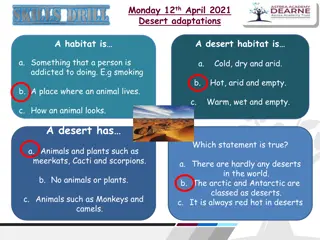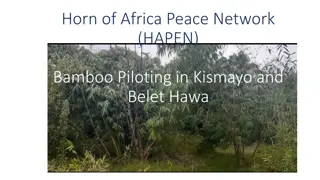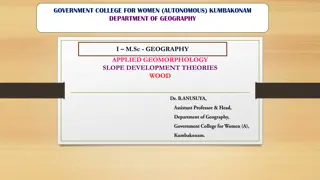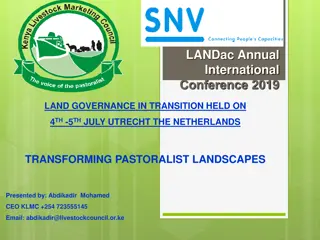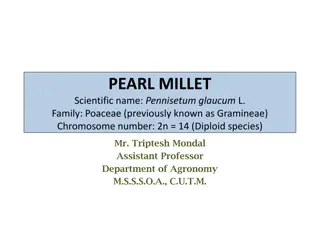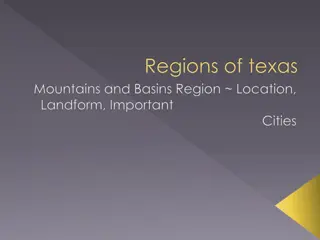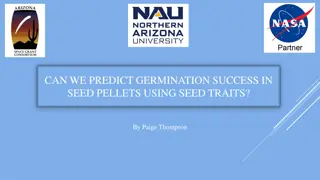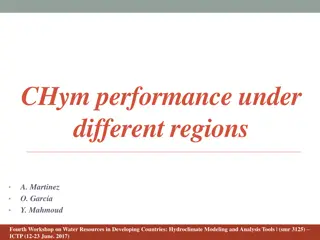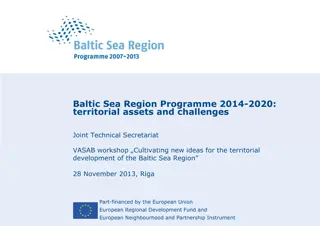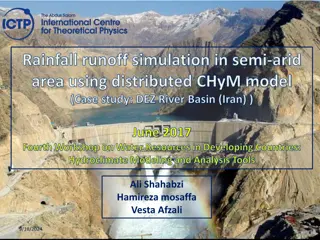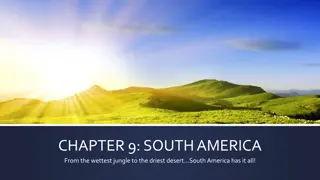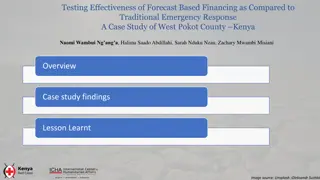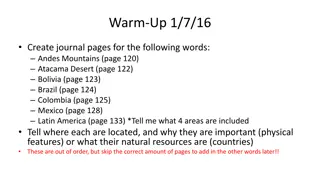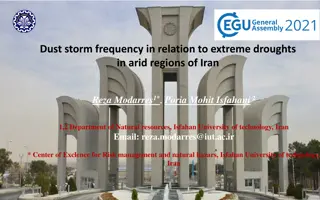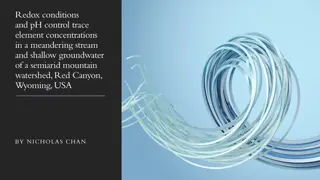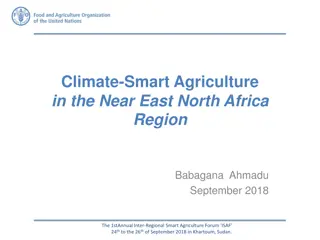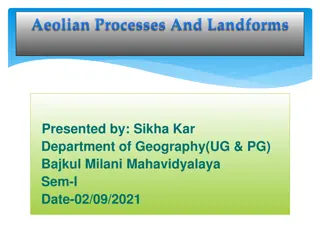Understanding Alluvial Fans: Formation, Characteristics, and Morphology
Alluvial fans are cone-shaped landforms formed by streams carrying sediments from mountains onto plains. They are prominent in arid to semi-arid regions and vary in size from a few meters to over 150 kilometers. The different zones of an alluvial fan, including the fan apex and distal fan, display d
5 views • 9 slides
Aeolian Landforms: Shaping Earth's Surface Through Wind Action
Geomorphic processes, including aeolian processes, play a significant role in modifying the earth's surface. This article delves into how wind erosion and deposition create unique landforms such as ventifacts and yardangs. Understanding the transportation methods and topographic effects of wind eros
0 views • 22 slides
Climate and Climatic Regions of Pakistan
Pakistan exhibits diverse climatic regions ranging from sub-tropical continental mountains to arid desert plateaus. Factors like altitude, latitude, and distance from the sea greatly influence the country's climate. The country experiences weather conditions such as temperature variations, rainfall
0 views • 14 slides
Social Conditions in the Sangam Age
The Sangam Age in Tamil Nadu saw a diverse society divided into regions based on landscape, with distinct occupations and deities. People in the Kurinji region were hunters, Mullai region herded animals, Marudham region focused on agriculture, Neydal region engaged in fishing, and Palai region strug
0 views • 12 slides
Desert Adaptations: Animals and Habitat Survival
Habitats play a crucial role in the survival of animals, especially in harsh environments like deserts. Explore the unique adaptations of animals like camels and learn how they are perfectly suited to thrive in hot, arid conditions. Understanding these adaptations is key to appreciating the diversit
0 views • 16 slides
Harnessing Bamboo for Sustainable Agriculture in Somalia
The Horn of Africa Peace Network (HAPEN) is piloting bamboo cultivation in Kismayo and Belet Hawa to combat desertification and promote sustainable agriculture. Bamboo, a versatile plant, offers a renewable resource that can thrive in various climates, including the arid regions of Somalia. The init
0 views • 5 slides
Understanding Drought as a Geohazard in South Texas
South Texas faces chronic water scarcity due to its semi-arid climate, leading to frequent droughts. This lecture explores the unique characteristics of drought as a geohazard, its specific risks, and the societal impacts it can cause, including direct meteorological and hydrological effects, as wel
0 views • 13 slides
Slope Development Theories in Applied Geomorphology
Slopes are formed through different processes as described by Wood's slope development theories, such as the Four Unit Slope Model and the 9-Unit Slope Model. These models illustrate various manifestations of slope profiles based on factors like rock composition and water movement. Different slope t
0 views • 10 slides
Aeolian Landforms and Processes: A Geographical Study by Ms. Annu
Geomorphic processes are crucial in shaping the Earth's surface, with Aeolian processes driven by wind erosion, transportation, and deposition. This study explores the topographic effects of wind erosion, transportation methods, and the formation of Aeolian landforms like ventifacts and yardangs. Th
0 views • 22 slides
Challenges Faced in Isiolo County, Kenya's Arid Region
Isiolo County in Kenya, characterized by arid and semi-arid lands, faces challenges related to fragile ecosystems, climate change impact, land use competition, breakdown of traditional resource systems, and tribal conflicts. This poses threats to the nomadic pastoral way of life and sustainable land
0 views • 10 slides
Pearl Millet - Overview, Economic Importance, and Cultivation
Pearl millet (Pennisetum glaucum L.) is a vital coarse grain crop, known for its drought tolerance and nutritional value. Also called bajra, it serves as staple food, poultry feed, and cattle fodder. Originating from Africa, pearl millet is widely cultivated in semi-arid regions of India, Africa, an
7 views • 22 slides
Understanding Region PTAs and Their Leadership Structure
Region PTAs are arms of the State PTA that carry out state programs, strengthen local units/councils, and provide leadership training. Region PTA leaders, including Directors and Assistant Directors, play crucial roles in supporting local PTAs and guiding them towards success. This article explores
1 views • 13 slides
Explore the Mountains and Basins Region of Texas
Discover the unique Mountains and Basins Region of Texas, located in the far west with the Rio Grande as its southern border and New Mexico to the north. This region features diverse landforms including mountains, plateaus, basins, deserts, and rivers like the Pecos and Rio Grande. Important cities
0 views • 19 slides
Social Economy and Innovation in Emilia-Romagna Region
Emilia-Romagna Region in Italy highlights the importance of social economy and innovation for sustainable development. Various initiatives such as Social Cooperatives and Voluntary Associations contribute to the region's social well-being. The focus on social values and not-for-profit activities dri
1 views • 15 slides
Intercultural Trends in the Euro-Med Region: Jordan Results
The Anna Lindh Foundation commissioned Ipsos to conduct an opinion poll on intercultural trends in the Euro-Mediterranean Region, including Jordan. The survey covered various aspects such as Mediterranean way of life, hospitality, common cultural heritage, migration issues, and resistance to change.
1 views • 37 slides
Wind as a Geologic Agent in Shaping Landscapes
Wind has played a significant role in shaping landscapes during times of drier climates, being a key geologic agent impacting erosion and deposition processes. The global wind system, driven by factors such as heating from the sun and the rotation of the Earth, creates convection currents that circu
0 views • 31 slides
Enhancing Restoration Success with Seed Pellets: A Study on Predicting Germination in Arid Environments
Ecological restoration in arid lands often faces challenges with seeding projects. This study explores using seed pellets to predict germination success by matching seed traits with pellet characteristics. The hypotheses focus on seed size and species comparison to improve restoration practices.
0 views • 13 slides
Analysis of CHyM Model Performance in Different Regions
The study evaluates the performance of the CHyM model in humid and arid regions, specifically focusing on Tropical South America and Central America. Through analyzing simulated values, seasonal behavior, and response to ENSO phases, the study provides insights into water resource management in thes
0 views • 16 slides
Territorial Development in the Baltic Sea Region Programme 2014-2020
The Baltic Sea Region Programme 2014-2020 focuses on sustainable regional development through transnational cooperation projects, addressing territorial challenges, and fostering place-based growth. It covers 11 participating countries and aligns with the EU Strategy for the Baltic Sea Region, provi
1 views • 11 slides
Understanding Climate Classification Systems
Climatology explores the classification of climates based on vegetation distribution, average temperatures, precipitation patterns, and seasonal variations. This system categorizes climates into groups like tropical, dry, mild temperate, continental, and polar. Each group further delineates specific
0 views • 8 slides
Integrated Drought Risk Management in Latin America and the Caribbean
Managing water resources in arid and semi-arid regions of Latin America and the Caribbean involves addressing climate risks through integrated drought risk management. Tools such as National Drought Observatories, Latin American Flood and Drought Monitor, and the Latin American Drought Atlas aid in
0 views • 14 slides
Rainfall-Runoff Simulation in Semi-Arid Area Using Distributed CHyM Model: DEZ River Basin Study
This case study delves into the simulation of rainfall-runoff using the CHyM model in the semi-arid area of the DEZ River Basin in Iran. The study focuses on water resources management, flood control, and forecasting of flood discharge parameters, emphasizing the importance of accurate modeling for
0 views • 22 slides
Overview of MiMaRoPa Region: Population, Education, and Labor Force Statistics
MiMaRoPa region, consisting of Oriental Mindoro, Marinduque, Occidental Mindoro, Romblon, and Palawan, covers a land area of 2,745,601 hectares with a population of over 2.9 million as of the 2015 census. The region has a significant number of registered programs, TVIs, assessors, and assessment cen
0 views • 37 slides
Discovering the Region of Zlín in the Czech Republic
The region of Zlín in the Czech Republic is known for its diverse landscape, rich history, and cultural significance. Situated in the eastern part of the country, the region offers mountainous terrains in the north and east, while the central and southern areas feature hilly and flat landscapes. De
0 views • 10 slides
The Noble Camel: General Information, Physical Characteristics, Habitats, Behaviors, and Interesting Facts
The Camelus Dromedarius, known as the camel, has distinctive characteristics such as its hump(s) for storing fat and surviving in deserts and semi-arid grasslands. Camels can endure extreme heat, lack of water, and can go months without drinking due to their unique adaptations. They are herbivores,
0 views • 6 slides
Understanding Ecosystems: Climate, Biomes, and Management
Explore the relationship between climate and biomes on a global scale, focusing on hot semi-arid grasslands and one other biome. Learn about the physical processes linking living and non-living components in ecosystems, such as nutrient cycles and food webs. Discover how small-scale ecosystems in th
0 views • 4 slides
Exploring the Diverse Landscapes of South America
South America boasts a varied topography, from the majestic Andes mountains to the expansive Amazon River basin. Its rugged landscapes have both attracted and isolated communities over time. Discover the high plains of the Altiplano, the arid beauty of Patagonia, and the lush grasslands of the llano
0 views • 19 slides
Effectiveness of Forecast-Based Financing in Emergency Response: A Case Study of West Pokot County, Kenya
Extreme weather conditions are increasingly impacting regions worldwide, especially arid areas like West Pokot County, Kenya. To address these challenges, the Kenya Red Cross Society implemented a Forecast-Based Financing (FBF) system in partnership with the FBF technical working group. By testing t
0 views • 14 slides
Region IV Public Health Training Center Overview
The Region IV Public Health Training Center (PHTC) is dedicated to strengthening the competence of the public health workforce in HHS Region IV. It provides professional development opportunities for both current and future public health professionals through training programs, field placements, and
0 views • 33 slides
Adaptations of Xerophytes in Different Habitats
Xerophytes, plants adapted to dry habitats, possess specific adaptations to prevent excessive water loss such as sunken stomata, presence of hairs, thick waxy cuticle, and rolled leaves. These adaptations help xerophytes thrive in arid conditions, maintaining humid air around stomata and maximizing
0 views • 13 slides
Discovering South America: Landscapes and Resources
Explore the diverse regions of South America, from the majestic Andes Mountains to the arid Atacama Desert, the vibrant countries of Bolivia, Brazil, Colombia, and Mexico, and the rich tapestry of Latin America. Learn about the physical features and natural resources that make these areas unique and
0 views • 19 slides
Fascinating Desert Animals and the Resilient Camel
Discover the intriguing world of desert animals, including the swift mongoose known for hunting in groups, and the remarkable camel, capable of surviving long periods without water. Learn about the unique characteristics and survival techniques of these creatures in the arid desert environment.
0 views • 4 slides
Veneto Region Territorial Cooperation and Macroregional Strategies Unit Overview
The Veneto Region in Italy is actively involved in European Territorial Cooperation (ETC) Programs, focusing on the MED Programme. The region's internal organization, led by the Territorial Cooperation and Macroregional Strategies Unit, is dedicated to setting policies, providing human resources for
0 views • 11 slides
Investigating Dust Storm Frequency and Extreme Drought Relationship in Arid Regions of Iran
This research by Reza Modarres and Poria Mohit Isfahani from Isfahan University of Technology explores the temporal changes in dust storm frequency in arid regions of Iran, examining how drought impacts the frequency in changing environments and the relation between extreme droughts and dust storm o
0 views • 14 slides
Redox Conditions and pH Control in a Mountain Watershed: Study in Red Canyon, Wyoming, USA
Exploring redox conditions and trace element concentrations in a semi-arid mountain watershed, this study in Red Canyon, Wyoming, delves into the impact of oxic surface water and anoxic groundwater on trace element cycling. The investigation aims to enhance understanding of seasonal variabilities, f
0 views • 11 slides
Understanding Deserts and Desertification: Lecture Insights by Maher M. Mahdi
Delve into the world of deserts and desertification with valuable insights collected by Maher M. Mahdi. Explore definitions of deserts, steppe regions, and semi-arid climates. Learn about the dryness ratio, distinguishing factors between true deserts and semi-deserts, and Budyko-Lettau dryness ratio
0 views • 22 slides
Water Harvesting Techniques in Rainfed Agriculture & Watershed Management
Water harvesting plays a crucial role in rainfed agriculture by collecting and storing runoff water for irrigation in arid and semi-arid regions. Mr. Anil Swami, an assistant professor, discusses the importance of water harvesting techniques, including runoff farming and rainwater harvesting. He emp
0 views • 13 slides
Challenges and Vulnerabilities of Climate-Smart Agriculture in the Near East North Africa Region
Climate change poses major challenges to sustainable agriculture in the Near East North Africa region, impacting food security, water availability, and overall agricultural productivity. The region is highly vulnerable to the negative effects of climate change, with increased water scarcity and chan
0 views • 21 slides
Understanding Aeolian Processes and Landforms
Aeolian processes are crucial in arid and semi-arid regions, involving erosion, transportation, and deposition by wind. Factors like wind velocity, grain size, rock composition, and vegetation influence erosion. Different types of wind erosion include deflation, abrasion, and attrition. The transpor
0 views • 18 slides
Construction Administration Training for Southwest Region
This content covers various topics related to construction administration training for the Southwest region, including preconstruction, project start during construction, information and procedures typically found in a region pantry, website resources for design and construction updates, software in
0 views • 59 slides




